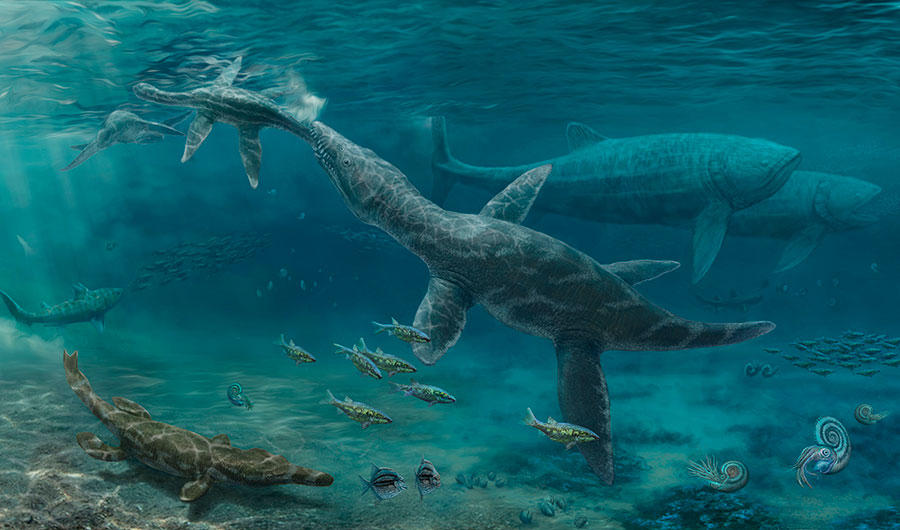How Marine Reptiles Reacted to Changing Conditions During Age of Dinosaurs

An artistic reconstruction of the Oxford Clay Formation, depicting a Middle Jurassic ecosystem with a plesiosaur (upper left), a large predatory pliosaurid (center), a metriorhynchid crocodyliform (bottom left) and the giant fish Leedsichthys (upper right).
Nikolay Zverkov
(Inside Science) -- The seas once teemed with marine reptiles such as long-necked plesiosauroids resembling the Loch Ness Monster and dolphin-shaped ichthyosaurs. Now fossil teeth are revealing insights on how these reptiles adapted to changing waters, yielding clues on how sea life might respond today.
While dinosaurs ruled the land for nearly 200 million years during the Mesozoic Era, a diversity of marine reptiles dominated the oceans. However, the patchy nature of the fossil record left much unknown regarding how these reptiles interacted with each other and other sea life, or how these relationships changed over time.
"Marine reptiles are a notoriously understudied group -- working out their relationships with each other has been difficult," said Mark Norell, chair of paleontology at the American Museum of Natural History in New York.
To shed light on these mysteries, scientists examined the most common marine reptile fossils: teeth, which are often preserved in the absence of more complete skeletal remains. They analyzed thousands of teeth kept in a dozen museums, focusing on 122 teeth from roughly 50 species excavated from sites across England.
More stories from Inside Science on Dinosaurs and Ancient Environments
These fossils came from an 18-million-year span between 148 million to 166 million years ago. Back then, most of England was covered by the so-called Jurassic Sub-Boreal Seaway, "a tropical, warm and shallow but deepening sea," said study lead author Davide Foffa, a vertebrate paleontologist at the University of Edinburgh in Scotland. Other denizens of the seaway would have included what may be the largest fish to ever live, the 16.5-meter Leedsichthys; extinct relatives of the modern nautilus known as ammonites; and extinct relatives of squids known as belemnites, he said.
Previous work unearthed marine reptile fossils from the beginning and the end of this 18-million-year period. For this new study, the researchers discovered many teeth from the middle of this span, helping fill in the gaps regarding marine reptile ecology and evolution at this site.
The size and shape of the teeth offered clues about what the marine reptiles they belonged to once ate, and the paleontologists found they could divide these reptiles into five groups based on their diet. For instance, plesiosauroids had thin pointed teeth good for eating fish and squid, while ichthyosaurs had conical teeth good for smashing soft prey.
These marine reptile groups likely stayed confined to their specialized niches, enabling many species to live together without competition. This pattern resembles the food chains of modern oceans, where many different species can coexist in the same area because they do not fight over the same resources.
The researchers also found that during this period, as global sea levels rose, there was a dramatic decline in marine reptiles that lived in shallower waters and caught fish and squid. At the same time, marine reptiles that lived in deeper waters thrived and diversified, including predators that specialized on hard targets such as turtles or on large prey.
Modern oceans follow a similar pattern -- smaller marine mammals that eat fish and squid, such as bottlenose dolphins, favor shallower waters, whereas larger species that can target bigger prey, such as orcas, prefer deeper waters, Foffa said. This may simply be because deeper waters can support larger animals, he said.
These findings imply that ecological rules dictate how marine creatures "interact with each other and with other groups of animals in their ecosystems, regardless of whether they are mammals or reptiles," said vertebrate paleontologist Kenneth Angielczyk at the Field Museum in Chicago, who did not take part in this research. Future research can study whether marine animals that lived in other time periods also followed these rules, said Norell, who also did not participate in this study.
All in all, this research reveals how fossils can help explain the consequences of changing habitat conditions, Foffa said. "If our results are accurate, the evolution of marine reptiles and their ecosystems was deeply impacted by changing environments. As our planet is going through severe environmental changes, this sort of study may help us better understand how our world may be changing with climatic changes, habitat loss, and so on."
The scientists detailed their findings online September 3 in the journal Nature Ecology & Evolution.

